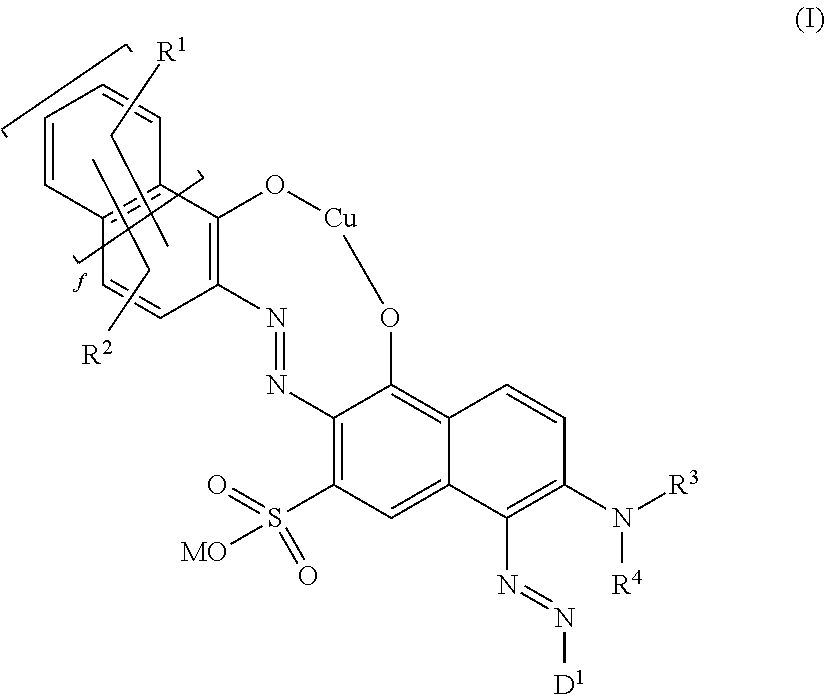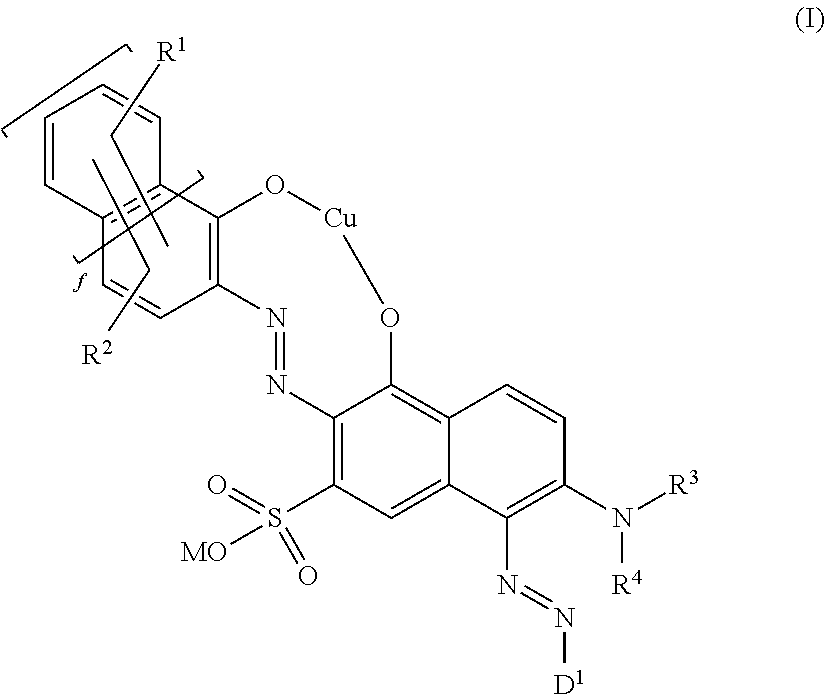Fiber-reactive copper complex disazo dyes
- Summary
- Abstract
- Description
- Claims
- Application Information
AI Technical Summary
Benefits of technology
Problems solved by technology
Method used
Image
Examples
example 1
[0151]34.1 parts of 2,5-dimethoxy-4-(β-sulfatoethylsulfonylyaniline are suspended in 70 parts of ice / water and 18 parts of 30% strength hydrochloric acid, and diazotization is carried out by dropwise addition of 17.5 parts of 40% strength sodium nitrite solution.
[0152]After the excess nitrite has been removed using amidosulfonic acid solution, the resulting diazo suspension is pumped into an aqueous solution of 69.1 parts of the red monoazo dye of the formula (16-1)
[0153]
which has been obtained by diazotizing 36.1 parts of 2-amino-5-(β-sulfatoethylsulfonyl)-benzenesulfonic acid with 17.5 parts of 40% strength sodium nitrite solution in an acidic medium and carrying out subsequent coupling to 25.3 parts of 4-hydroxy-7-(methyl-amino)-naphthalene-2-sulfonic acid at a pH of 1-1.5. Subsequently, below 25° C., sodium carbonate is used to set a pH of 5-6, and the mixture is held for approximately 1 h until the coupling reaction is at an end. The resultant aqueous solution of the bluish-red...
example 2
[0158]28.1 parts of 4-(β-sulfatoethylsulfonyl)-aniline are suspended in 70 parts of ice / water and 18 parts of 30% strength hydrochloric acid and diazotized by dropwise addition of 17.5 parts of 40% strength sodium nitrite solution. Following removal of the excess nitrite with amidosulfonic acid solution, the resulting diazo suspension is pumped into an aqueous solution of 69.1 parts of the red monoazo dye of the formula (16-1), which was obtained by diazotizing 36.1 parts of 2-amino-5-(β-sulfatoethylsulfonyl)-benzenesulfonic acid with 17.5 parts of 40% strength sodium nitrite solution in an acidic medium, followed by coupling to 25.3 parts of 4-hydroxy-7-(methyl-amino)-naphthalene-2-sulfonic acid at a pH of 1-1.5. Subsequently, at below 25° C., a pH of 5 is set using sodium carbonate, and the batch is held for about 1 h until the coupling reaction is at an end. The resulting aqueous solution of the brown-red disazo dye of the formula (13-2)
[0159]
(absorption maximum 522 nm) is subseq...
example 3
[0163]a) 28.1 parts of 4-(β-sulfatoethylsulfonyl)-aniline are suspended in 70 parts of ice / water and 18 parts of 30% strength hydrochloric acid and diazotized by dropwise addition of 17.5 parts of 40% strength sodium nitrite solution. Following removal of the excess nitrite with amidosulfonic acid solution, the resulting diazo suspension is admixed with an aqueous solution of 33.3 parts of 4-hydroxy-7-(sulfomethyl-amino)-naphthalene-2-sulfonic acid, which has been obtained by reaction of 23.9 parts of 7-amino-4-hydroxy-naphthalene-2-sulfonic acid with 15 parts of formaldehyde-sodium bisulfite in aqueous medium at a pH of 5.5-6 and at 45° C., and is adjusted to a pH of 1.5 using solid sodium hydrogen carbonate. This is followed by stirring at a pH of 1.5 and at 15-20° C. until the acidic coupling reaction is at an end.[0164]b) In a separate reaction vessel, 38 parts of 3-amino-2-hydroxy-5-(β-sulfatoethylsulfonyl)-benzenesulfonic acid are suspended in 75 parts of ice / water and 18 part...
PUM
| Property | Measurement | Unit |
|---|---|---|
| Equivalent mass | aaaaa | aaaaa |
Abstract
Description
Claims
Application Information
 Login to View More
Login to View More - R&D
- Intellectual Property
- Life Sciences
- Materials
- Tech Scout
- Unparalleled Data Quality
- Higher Quality Content
- 60% Fewer Hallucinations
Browse by: Latest US Patents, China's latest patents, Technical Efficacy Thesaurus, Application Domain, Technology Topic, Popular Technical Reports.
© 2025 PatSnap. All rights reserved.Legal|Privacy policy|Modern Slavery Act Transparency Statement|Sitemap|About US| Contact US: help@patsnap.com



